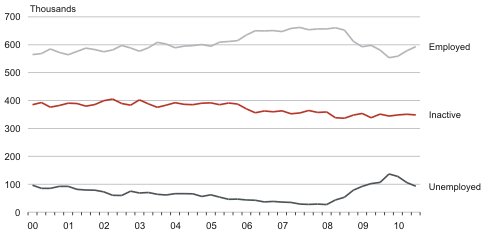Unemployment decreased at the end of the year
According to the data of the Labour Force Survey, the estimated number of unemployed persons, which rose to record high 137,000 persons in the 1st quarter of 2010, decreased continuously in the following quarters. In the 4th quarter, for the first time during the last one and a half year the unemployed persons numbered less than 100,000 and the unemployment decreased compared to the previous quarter as well as to the same quarter of the previous year.
The unemployment among men is continually higher than unemployment among women, but the difference between the unemployment rate of men and that of women has significantly decreased. If the unemployment rate of men, which rose to 25.2% in the 1st quarter of 2010 was 10.6 percentage points higher than that of women, then in the 4th quarter the difference was only 1.2 percentage points. The unemployment rate of men was 14.2%, the unemployment rate of women 13%.
In the 2nd and 3rd quarters of 2010, the unemployment decreased mainly due to the decreasing number of persons who had been unemployed less than a year, but in the 4th quarter the long-term unemployment decreased remarkably. The number of unemployed persons who had been looking for a job for one year or more decreased by 10,000 compared to the previous quarter and the share of long-term unemployment decreased from 53% to 49%. The discouraged persons or persons who had stopped seeking for a job numbered in the 4th quarter still slightly more than in the 3rd quarter (10,000 and 9,000, respectively).
In the 4th quarter, the estimated number of employed persons was 593,000, which is by 15,000 (2.5%) bigger compared to the previous quarter and by 12,000 (2.1%) bigger compared to the same quarter of the previous year. The employment increased mainly due to the increased number of persons employed in manufacturing.
During the last three quarters the unemployment declined, but in 2010 the annual average number of unemployed persons was still the largest during the period after the restoration of independence in Estonia. In 2009 the number of unemployed persons increased to 95,000 and was bigger than in 2000 (90,000), the year of biggest unemployment during the previous economic crisis, but there were even more unemployed persons in 2010 — 116,000. The annual average unemployment rate was 16.9% in 2010, 13.8% in 2009.
In 2010, the annual average number of employed persons was 571,000, which is by 25,000 (4.2%) less than in 2009. The economically inactive persons (students, retired persons, homemakers, discouraged persons, etc.) aged 15–74 numbered 348,000, same as a year earlier.
Persons aged 15–74 by labour status, 2000–2010
The unemployment rate is the share of the unemployed in the labour force (sum of employed and unemployed persons). The estimates are based on the data of the Labour Force Survey. Statistics Estonia has been conducting the Labour Force Survey since 1995 and every quarter 5,000 persons participate in it. The Labour Force Survey is carried out by statistical organisations in all the European Union Member States on the basis of harmonised methodology.
